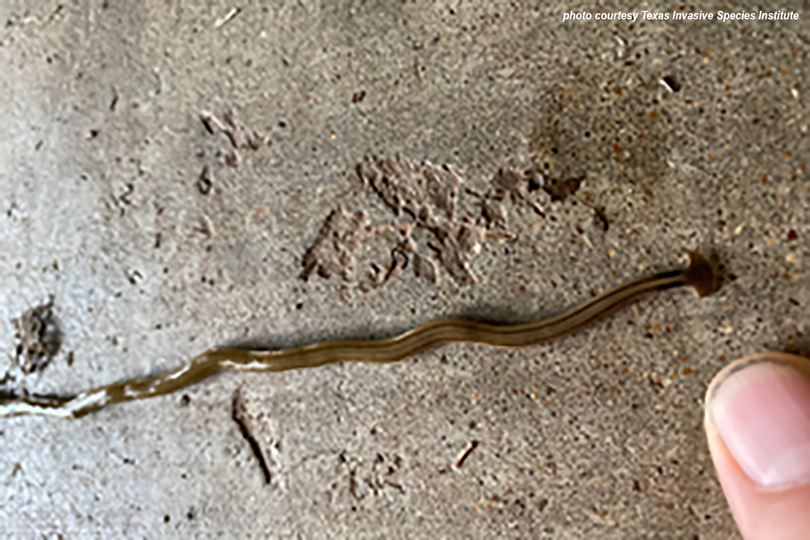By Jennifer Whitlock
Field Editor
Recent findings of the hammerhead flatworm in Lamar County, located in the northeast corner of Texas, have area Texas A&M AgriLife Extension Service specialists concerned.
That’s because the invasive species has never been seen in this part of East Texas before, according to Lamar County AgriLife Extension Agent Jessica Humphrey.
“A lady messaged me on my Lamar County Ag & Natural Resources Facebook page asking what it was. She had one in her house,” Humphrey said in an interview with the Texas Farm Bureau Radio Network. “It looks like an earthworm, but instead of having a pointy head, it almost looks like the head of a hammerhead shark.”
Originating in Southeast Asia, the hammerhead flatworm likely entered the U.S. in the early 1900s aboard imported landscaping materials. It is a terrestrial flatworm, typically honey-colored with one to five dark stripes running the length of the body. The Texas Invasive Species Institute reports the body as being narrow, “snake-like” and up to 15 inches long, with 8-12 inches being the most common.
The hammerhead flatworm could be very detrimental to area agriculture if the population grew too large, since Humphrey said they are known earthworm predators.
“Earthworms are crucial for aeration of the soil and breakdown of the soil and things like that,” she said. “Right now, we’re finding them in lawns and gardens, but if they get bad enough, they’ll migrate to our crops and that would affect soil health.”
The creatures can reproduce via “fragmentation.” Any portion of the worm that is pinched off can begin to regenerate a new flatworm in about 10 days.
The species also secretes chemicals through the skin to make themselves noxious to predators. The chemicals can cause skin irritation in humans who handle the flatworm and in pets or other domestic mammals who consume the worms. They may carry parasitic nematodes, so Humphrey recommended wearing gloves and digging carefully when trying to catch a hammerhead flatworm.
“If you find them, dig them up whole and put them in a sealable plastic storage bag with salt to kill them, and then you can dispose of them in the bag after that,” she said.
Citrus oil and vinegar are other effective methods of extermination but must be applied directly to the flatworm. Placing them in a sealed bag or container ensures they do not crawl away after treatment.
Currently, there are no other known methods of control or bait that can eliminate the invasive flatworm without harming the ecologically-friendly earthworm, though Humphreys said there are several studies underway to find new chemicals or methods to control them.
She advised those who find a hammerhead flatworm to contact their local Extension agent to let them know it’s been spotted in that area. The Texas Invasive Species Institute also requests people to submit a photo and the location coordinates to Asley Morgan-Olvera at invasives@shsu.edu so they may track the spread of the invasive species.
More information on the hammerhead flatworm is available at the Texas Invasive Species Institute and at TexasInvasives.org.


Recently killed Hammerhead flatworm in Northern Burnet County by dropping in zip bag loaded with
salt.
I killed 2 on my back porch last month. Didn’t know what they were. Bayview, Texas Cameron county
We have found two and killed them with the plastic bag and salt. Lake Palestine, Smith County.
I salted one a few weeks ago in rockdale county
I’ve killed a few in Tarrant County
I had a lot of them last year bot have only seen one this year and I burned it I’m eufala, alabama
Found 2.on my porch in Gulfport Ms
The Southern California coast has an investation of new world screwworms. The crows are gone and all the other animals are dying or spraying these flesh eating Larva wherever they go.
My chickens love to eat them. There in SC
Found 2-3 in my back yard in Paris Texas.Thanks now i know what to do with them an what they are.
About 55 years ago, this kind of worm was seen in Port Arthur, Texas.
I’ve seen 6 or 7 of these creepy things he thinks and in Hoover Alabama Currently renting off my fingers because I touched it barehanded
Found one in Bayview Texas. Galveston County
Found one in Alexander City Al
Found 1 in Terrell Texas